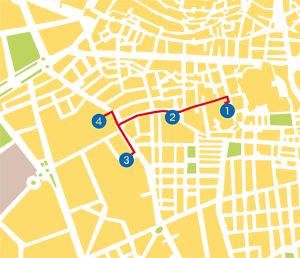
During the whole of the sixteenth century the city continues to expand and make itself richer with new buildings, some of which now show traces of baroque.
This last route which has as its axis the street of San Jeronimo has on show for the traveller the Monastery of San Jeronimo; the Hospital and Church of San Juan de Dios; the Church of Los Santos Justos y Pastor; the Plaza de la Universidad and the Casa de los Vargas. The Monastery of San Jeronimo is framed within the expansion of the european model of a modern capital.One is talking of a superb monastic precinct, wherein are laid to rest the remains of Gran Capitán,Fernando González de Córdoba. From the Cathedral up to the anterior building, the Basilica of San Juan de Dios runs beside the road,where the saint was buried. The temple is a splendid example of granadinan baroque. Nearby one encounters the University square, an institution founded by Carlos the fifth in 1528. In the centre of the square the statue of the sovereign stands out. In the same square one finds the baroque church of Los Santos Justos y Pastor, a magnificent building in baroque style, the construction of which was begun in 1575 and in which the great altar decorated by Bocanegra is worthy of mention.
| 



 Ayuntamiento de Granada
Ayuntamiento de Granada

